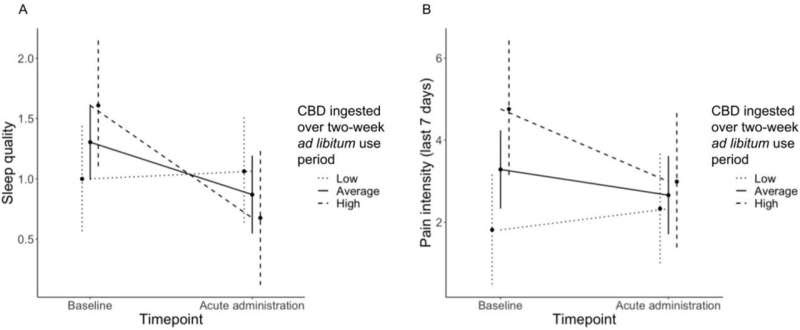by Lisa Marshall, University of Colorado at Boulder

Time X CBD ingested over two-week ad libitum use period interactions for (A) sleep quality and (B) pain intensity over the last seven days. Sleep quality was rated on a scale from 0 (“very good”) to 3 (“very bad”), such that lower values reflect higher ratings of sleep quality. Pain intensity was rated on a scale from 0 (“no pain”) to 10 (“worst pain imaginable”), such that lower values reflect lower ratings of pain intensity. Credit: Exploration of Medicine (2023). DOI: 10.37349/emed.2023.00138
Angela Bryan had been studying cancer prevention for years and had just started studying cannabis use among cancer patients when, in 2017, her personal and professional lives collided in a way she’d never imagined: She was diagnosed with breast cancer.
Hesitant to take opioids for post-surgical pain, she asked her doctors what they thought about her using the herb medicinally.
“They were so supportive of what I wanted to do, but they had no idea what to tell me,” said Bryan, a professor of psychology and neuroscience at CU Boulder. “There was just no data.”
Fast forward six years, and a small but groundbreaking study helps to fill that gap, showing that cancer patients who use cannabis to address their symptoms have less pain, sleep better and experience another, unexpected, benefit:
After a few weeks of sustained use, they seem to think more clearly.
When you’re in a lot of pain, it’s hard to think,” said Bryan, the study’s senior author. “We found that when patients’ pain levels came down after using cannabis for a while, their cognition got better.”
The study, published in the journal Exploration in Medicine, is among the first to assess how cannabis bought over the counter at dispensaries— rather than government-supplied or synthetic varieties—impacts cancer symptoms or chemotherapy side effects.
It also sheds light on the wide variety of products cancer patients use now that marijuana is legal in most states.
Bringing the lab to the patients
Surveys suggest that as many as 40% of U.S. cancer patients use cannabis, yet only a third of doctors feel comfortable advising them about it.
Studying it is complicated, because federal law prohibits university researchers from possessing or distributing cannabis for research unless it’s government-issued or of pharmaceutical grade. As a result, most studies have looked only at prescription products like nabilone or dronabinol (typically prescribed for nausea) or government cannabis strains that tend to be less potent and lack the variety of over-the-counter offerings.
For the study, Bryan collaborated with oncologists Dr. Ross Camidge and Dr. Daniel Bowles at the CU Anschutz Medical Campus to observe 25 cancer patients who used cannabis over two weeks.
After a baseline appointment in which their pain levels, sleep patterns and cognition were assessed, they were asked to purchase the edible product of their choosing from a dispensary. Choices were surprisingly varied, spanning 18 brands, including chocolates, gummies, tinctures, pills, and baked goods, and contained varying ratios of THC and CBD at a wide range of potencies.
“This tells us that people are open to trying whatever they think might be useful, but there’s just not much data out there to guide them on what works best for what,” said Bryan.
To study acute impacts, researchers drove a “mobile laboratory” (a Dodge Sprinter van sometimes referred to as the “cannavan”) to each patient’s home one day. Participants underwent physical and cognitive assessments in the van, then re-tested in the van after using cannabis in their homes.
After two weeks of sustained use at the frequency of their choice, they also had a follow-up exam.
Within an hour, the study found, cannabis eased patient’s pain significantly while also impairing their cognition and making them feel “high” (the higher the THC content, the higher they felt).
But longer term, a different pattern emerged: After two weeks of sustained use, patients reported improvements in pain, sleep quality and cognitive function. Some objective measures of cognitive function, including reaction times, also improved.
“We thought we might see some problems with cognitive function,” said Bryan, noting that both cannabis and chemotherapy have been previously associated with impaired thinking. “But people actually felt like they were thinking more clearly. It was a surprise.”
The more people’s pain subsided, the more their cognition seemed to improve.
Notably, those who ingested more CBD, a known anti-inflammatory, reported bigger improvements in both pain intensity and sleep quality.
While larger, controlled studies are needed before drawing conclusions, the authors say the findings raise an intriguing possibility: While some forms and dosages of cannabis for pain relief may impair thinking short-term, the treatment might improve cognition in the long run by reducing pain.
“We know oncologists and patients are concerned about the possible negative impact of cancer treatment on cognitive function, so the potential, indirect role of cannabis use on improving subjective cognitive function should be studied further,” said first author Gregory Giordano, a professional research assistant in the Department of Psychology and Neuroscience.
Personal experience
After surgery and chemotherapy, Bryan did turn to cannabis-infused edibles, creating her own custom regimen of more potent THC-heavy products when pain was intense and she could sacrifice some mental sharpness, and milder, CBD-heavy products to keep the pain manageable.
She was not pain-free, but she didn’t take a single opiate during her treatment.
“I was extremely lucky because I had some knowledge about this. Most patients don’t,” she said. “Either they don’t know it’s an option or they’ve got well-meaning but potentially under-informed budtenders advising them.”
She hopes her team’s research, and more studies to come, will enable doctors and patients to make better-informed decisions.

Leave a Reply